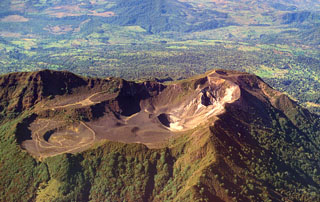Report on Turrialba (Costa Rica) — 21 November-27 November 2018
Smithsonian Institution / US Geological Survey
Weekly Volcanic Activity Report, 21 November-27 November 2018
Managing Editor: Sally Sennert.
Please cite this report as:
Global Volcanism Program, 2018. Report on Turrialba (Costa Rica) (Sennert, S, ed.). Weekly Volcanic Activity Report, 21 November-27 November 2018. Smithsonian Institution and US Geological Survey.
Turrialba
Costa Rica
10.025°N, 83.767°W; summit elev. 3340 m
All times are local (unless otherwise noted)
OVSICORI-UNA reported that at 0710 on 22 November an event at Turrialba generated an ash plume that rose 100 m above the crater rim and drifted W. The next day there were frequent pulses of ash. During 23-25 November occasional Strombolian explosions ejected lava bombs that were deposited near the crater; residents of Cascajal de Coronado reported hearing several booming sounds. Ash plumes rose as high as 500 m. During 26-27 November passive emissions with small quantities of ash were visible. Minor ashfall was reported in San Jose (Cascajal de Coronado and Dulce Nombre), San Pedro Montes de Oca, and neighborhoods of Heredia.
Geological Summary. Turrialba, the easternmost of Costa Rica's Holocene volcanoes, is a large vegetated basaltic-to-dacitic stratovolcano located across a broad saddle NE of Irazú volcano overlooking the city of Cartago. The massive edifice covers an area of 500 km2. Three well-defined craters occur at the upper SW end of a broad 800 x 2200 m summit depression that is breached to the NE. Most activity originated from the summit vent complex, but two pyroclastic cones are located on the SW flank. Five major explosive eruptions have occurred during the past 3500 years. A series of explosive eruptions during the 19th century were sometimes accompanied by pyroclastic flows. Fumarolic activity continues at the central and SW summit craters.
Source: Observatorio Vulcanologico y Sismologico de Costa Rica-Universidad Nacional (OVSICORI-UNA)

